Thermador PRD484WCGU, PRD606WCSG, PRD48WDSGU, PRG486WDG, PRG486WLG Installation Manual
...
INSTALLATION
I N S T R U C T I O N S
Professional Series Pro Grand® Ranges
THERMADOR.COM
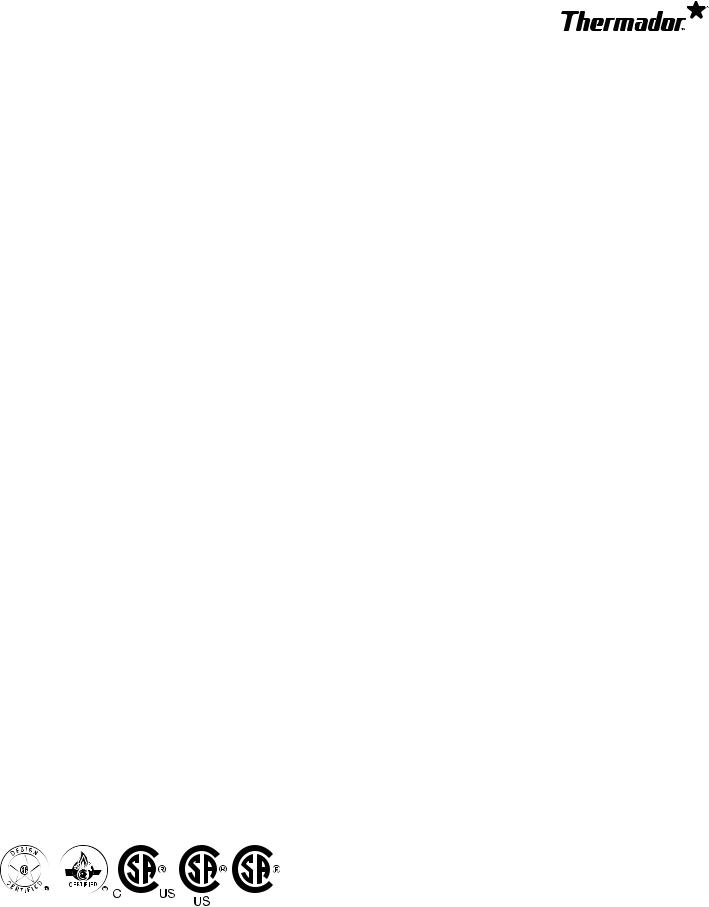
Installation
INSTRUCTIONS
Professional Series Pro Grand® Ranges |
|
Table of Contents (English) ............................................................... |
2 |
Table de Matières (Français) ........................................................... |
28 |
Índice de Materias (Español) ........................................................... |
55 |
Models |
Modèles |
Modelos:
PRD364WDGU/C
PRD364WIGU/C
PRD364WLGU/C
PRD366WGU/C
PRD484WCGU/C
PRD486WDGU/C
PRD486WIGU/C
PRD486WLGU/C
PRD48WCSGU/C
PRD48WDSGU/C
PRD48WISGU/C
PRD48WLSGU/C
PRD606WCG
PRD606WCSG
PRD606WEG
PRD606WESG
PRG364WDG
PRG364WLG
PRG366WG
PRG486WDG
PRG486WLG
THERMADOR.COM

Table of
CONTENTS
Safety ...................................................................................... |
3 |
Important safety instructions ........................................... |
3 |
Installation instructions .......................................................... |
6 |
Planning information ....................................................... |
6 |
Ventilation requirements ................................................ |
6 |
Installation clearances...................................................... |
7 |
Gas and electric locations ............................................... |
12 |
Unpacking and moving the range .................................. |
13 |
Door removal and adjustment ........................................ |
14 |
Installing the anti-tip bracket (required) ......................... |
16 |
Gas requirements and connection ................................. |
17 |
Electrical requirements and connection for |
|
GAS models..................................................................... |
18 |
Electrical requirements and connection for |
|
DUAL FUEL models ......................................................... |
19 |
Low backguard installation (optional) ............................. |
22 |
Placing and leveling the range ........................................ |
23 |
Data rating label .............................................................. |
24 |
Burner test ...................................................................... |
25 |
Installer checklist .................................................................... |
27 |
Final check ....................................................................... |
27 |
Support, accessories, and parts................................. |
back page |
Safety
DEFINITIONS
9 WARNING
This indicates that death or serious injuries may occur as a result of non-observance of this warning.
9 CAUTION
This indicates that minor or moderate injuries may occur as a result of non-observance of this warning.
NOTICE: This indicates that damage to the appliance or property may occur as a result of non-compliance with this advisory.
Note: This alerts you to important information and/or tips.
This THERMADOR® appliance is made by
BSH Home Appliances Corporation
1901 Main Street, Suite 600
Irvine, CA 92614
Questions?
1-800-735-4328 www.thermador.com
We look forward to hearing from you!
Page. 2
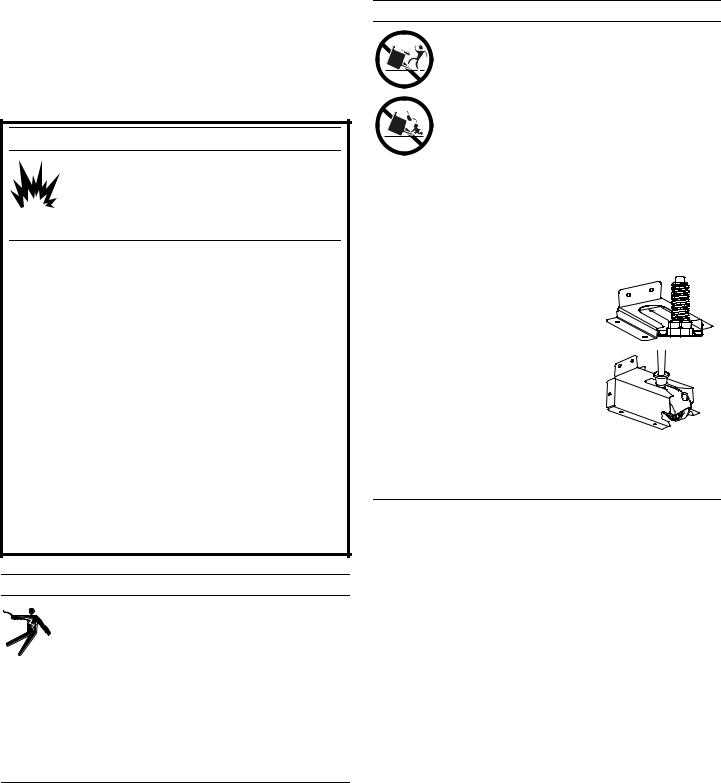
Safety
9 IMPORTANT SAFETY INSTRUCTIONS
READ AND SAVE THESE INSTRUCTIONS
Installer: Save these instructions for the local gas inspector’s use. Please leave these Installation Instructions with this unit for the owner.
Owner: Please retain these instructions for future reference. Before using your appliance, be sure to read this manual.
WARNING
If the information in this manual is not followed exactly, a fire or explosion may result causing property damage, personal injury or death.
--DO NOT store or use gasoline or other flammable vapors and liquids in the vicinity of this or any other appliance.
--WHAT TO DO IF YOU SMELL GAS
•DO NOT try to light any appliance.
•DO NOT touch any electrical switch.
•DO NOT use any phone in your building.
•Immediately call your gas supplier from a neighbor’s phone. Follow the gas supplier’s instructions.
•If you cannot reach your gas supplier, call the fire department.
--Installation and service must be performed by a qualified installer, service agency or the gas supplier.
WARNING
ELECTRICAL SHOCK HAZARD
• Disconnect power before installing or servicing. Before turning power ON, be sure that all controls are in the OFF position.
•DO NOT remove connections.
•DO NOT use an extension cord.
•Improper grounding can result in a risk of electric shock.
•Failure to follow these instructions can result in death, fire, or electrical shock.
WARNING
RANGE TIPPING HAZARD:
• All ranges can tip and injury can result. To prevent accidental tipping of the range, attach it to the floor by installing the anti-tip bracket supplied.
• A risk of tip-over may exist if the appliance is not installed in accordance with these instructions. For all ranges an anti-tip device MUST be installed.
•A child or adult can tip the range and be killed.
•DO NOT operate the range without the anti-tip device in place and engaged. Failure to do so can result in death or serious burns to children or adults.
• If the range is pulled away from the wall for cleaning, service or for any other reason, ensure that the antitip device is properly re-
engaged when the range is pushed back against the wall.
In the event of abnormal usage (such as a person standing, sitting, or leaning on an open door), failure to
take this precaution can result in tipping of the range. Personal injury might result from spilled hot liquids or from the range itself.
Local codes vary. Installer is responsible for ensuring that the installation, gas connections, and grounding comply with all applicable codes. Failure to follow appropriate local codes and regulations may void the warranty.
The installation of appliances designed for manufactured (mobile) home installation must conform with the Manufactured Home Construction and Safety Standard, Title 24 CFR, Part 3280 [formerly the Federal Standard for Mobile Home Construction and Safety, Title 24, HUD {Part 280}] or with local codes where applicable.
The installation of appliances designed for Recreational Park Trailers must conform with state or other codes or, in the absence of such codes, with the Standard for Recreational Park Trailers, ANSI A119.5.
Examine the appliance after unpacking it. In the event of transport damage, do not plug it in.
Page. 3

9 IMPORTANT SAFETY INSTRUCTIONS
READ AND SAVE THESE INSTRUCTIONS
Remove all tape and packaging before using the appliance. Dispose of packaging in an environmentallyresponsible manner. Never allow children to play with packaging material.
This appliance must be grounded. Grounding reduces the risk of electric shock by providing a safe pathway for electric current in the event of a short circuit.
Show the owner the location of the circuit breaker or fuse. Mark it for easy reference.
The appliance, when installed, must be electrically grounded in accordance with local codes or, in the absence of local codes, with the National Electrical Code, NFPA 70 latest edition, or the Canadian Electric Code, CSA C22.1-02.
DO NOT install this appliance outdoors.
For Massachusetts installations:
•Installation must be performed by a qualified or licensed contractor, plumber or gas fitter qualified or licensed by the state, province or region where this appliance is being installed.
•Shut-off valve must be a “T” handle gas cock.
•Flexible gas connector must not be longer than 36'' (914 mm).
Verify the type of gas supplied to the location. Ensure that the appliance is connected to the type of gas for which it is certified.
This appliance is capable of being safely placed in operation in the event of a power failure. Only the standard top burners can be manually lit.
Always keep appliance area clear from combustible materials, gasoline and other flammable vapors and liquids.
Natural gas — 7 inch water column. (17.4 mb) min., 14 inch (34.9 mb) maximum
Propane gas — 11 inch water column. (27.4 mb) min., 14 inch (34.9 mb) maximum
This appliance is shipped from the manufacturer for use with natural gas. For use with propane (LP) gas, a conversion kit must be purchased separately. An authorized servicer must do the LP conversion. See the back cover for information about service, parts, and accessories.
CAUTION
When connecting the unit to propane gas, make certain the propane gas tank is equipped with its own high-pressure regulator in addition to the pressure regulator supplied with the appliance. The maximum gas pressure to this appliance must not exceed 14.0'' water column (34.9 mb) from the propane gas tank to the pressure regulator.
This appliance complies with one or more of the following Standards:
•UL 858, The Standard for the Safety of Household Electric Ranges
•ANSI Z21.1, The American National Standard for Household Cooking Gas Appliances
•CAN1-1.1-M81, Domestic Gas Ranges
•CSA C22.2 No. 61, Household Cooking Ranges
Check local building codes for the proper method of appliance installation. Local codes vary; it is the responsibility of the installer to ensure installation is in accordance with these codes. Installation, electrical connections, and grounding must comply with all applicable codes.
In the absence of local codes the appliance should be installed in accordance with the National Electric Code NFPA 70 current issue and National Gas Code NFPA 54/ ANSI Z223.1 – current issue. In Canada, installation must be in accordance with the Canadian Electric Code, CSA C22.1-02 and the CAN 1-B149.1 and .2 – Installation Codes for Gas Burning Appliances and/or local codes.
State of California Proposition 65 Warning:
: WARNING
This product can expose you to chemicals including vinyl chloride, which is known to the State of California to cause cancer and birth defects or other reproductive harm. For more information go to www.P65Warnings.ca.gov.
Page. 4
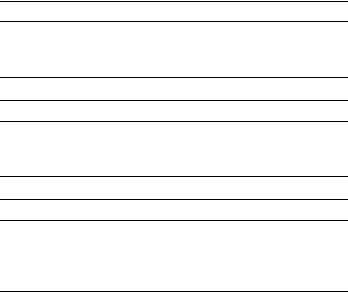
9 IMPORTANT SAFETY INSTRUCTIONS
READ AND SAVE THESE INSTRUCTIONS
Rear clearance requirements
•To avoid staining on the back wall, high temperature, non-porous construction materials suitable for use in a cooking environment are recommended.
•Models PCG305xx, PRG305xx, PRG304xx, PRD305xx, PRD304, and PRD606xx are suitable for 0'' rear clearance to combustible surfaces.
•All other models:
•When using the included island trim a minimum 6" (152 mm)* rear clearance is required to a combustible surface*.
•When installing against a combustible surface, a Thermador® low backguard is required for a 0'' rear clearance to the combustible surface. A Thermador low backguard must be purchased separately.
•A rear clearance to a surface covered in a non-
combustible material (metal, ceramic tile, brick, marble, or stone)* is 0" when using the included island trim.
*Clearances of less than 6'' (152 mm) should be approved by the local codes and/or by the local authority having jurisdiction.
Clearances from non-combustible materials are not part of the ANSI Z21.1 scope and are not certified by CSA.
WARNING
To avoid possible burn or fire hazard, a backguard designed specifically for this appliance should be installed whenever the appliance is used.
WARNING
To eliminate risk of burns or fire caused by reaching over heated surface units, cabinet storage located above the surface units should be avoided.
CAUTION
This unit is designed as a cooking appliance. Based on safety considerations, never use it for warming or heating a room. Doing so may result in carbon monoxide poisoning and overheating the appliance.
Page. 5

Installation instructions
Planning information
9 CAUTION
To prevent possible damage to cabinets and cabinet finishes, use only materials and finishes that will not discolor or divide into layers. Materials should be able to withstand temperatures up to 194 °F (90 °C). Heat and moisture resistant adhesive must be used if the product is to be installed in laminated cabinetry. Check with the manufacturer to ensure materials meet these requirements.
Before using your appliance, be sure to read this manual. Pay special attention to the “Important safety instructions” located at the beginning of the manual.
Tools needed
•7/16'' box end wrench or ratchet
•3/16'' (4.76 mm) drill bit
•Hand or electric drill
•1/8'' (3.17 mm) drill bit
•12'' Adjustable wrench
•T-20 screwdriver
•T-30 screwdriver
•Tape measure
•Furniture dolly or air sled
•Phillips screwdriver
•Level
•Marking instrument
•Protective gloves
•Safety glasses
Items not included
•Drywall / Concrete Anchors
•Rope/Twine
•2 – NPT Flare Adapters
•Pipe Compound / Tape
•¾'' (19 mm) Flex Line
IMPORTANT: There is a possibility to discolor the back wall under certain cooking conditions.
Ventilation requirements
9 WARNING
This appliance should not be installed with a ventilation system that directs air in a downward direction toward the range. This type of ventilation system may cause ignition and combustion problems with the appliance resulting in personal injury, property damage, or unintended operation. Ventilating systems that direct the air upwards do not have any restriction.
Refer to the “Ventilation planning guide” for approved ventilation combinations.
It is strongly recommended that this appliance be installed in conjunction with a Thermador® vent hood. Due to the high heat capability of this unit, particular attention should be paid to the hood and duct work installation to assure it meets local building codes.
Downdraft ventilation should not be used. The “Ventilation planning guide” indicates the ventilation hood options and blower capacity guidelines that are recommended for use.
Due to the high heat of the rangetop burners, installing a microwave oven with a ventilation system over the rangetop is not recommended.
Ventilation hoods and blowers are designed for use with single wall ducting. However, some local building codes or inspectors may require double wall ducting. Consult local building codes and/or local agencies before starting to assure that hood and duct installation will meet local requirements.
NOTICE: Most range hoods contain combustible components which must be considered when planning the installation.
Page. 6
Ventilation preparation
To prepare for the ventilation
1.Select hood and blower models:
•For wall installations, the hood width must, at a minimum, equal the width of the range/rangetop. Where space permits, a hood larger in width than the range/rangetop may be desirable for improved ventilation performance.
•For island installations, the hood width should overhang the width of the range/rangetop by a minimum of 3'' (76 mm) on each side.
2.Hood placement:
•For best smoke elimination, the lower edge of the hood should be installed 30'' (762 mm) above the range cooking surface.
•If the hood contains any combustible materials (i.e. a wood covering), it must be installed a minimum of 36'' (914 mm) above the cooking surface.
3.Consider make-up air:
•Due to the high volume of ventilation air, a source of outside replacement air is recommended. This is particularly important for tightly sealed and insulated homes.
•A qualified heating and ventilating contractor should be consulted.
Installation clearances
Cabinet requirements
The appliance is a free standing unit. If the unit is to be placed adjacent to cabinets, the clearances shown in this section are required. The same clearances apply to island installations, except for the overhead cabinets, which must have a space wide enough to accept the island hood.
•See the “Ventilation planning guide” for recommended hood options. Due to the high heat of the burners, installing a microwave oven with a ventilation system over the appliance is not recommended on any model other than the 30'' 5– burner. Refer to OTR manufacturer’s installation manual for clearances.
•The gas and electrical supply should be within the zones shown in the “Gas and electric locations” section.
•The shaded area behind the appliance indicates an opportunity to discolor the back wall under certain cooking conditions.
•There must be a minimum of 5'' (127 mm) side clearance from the appliance to combustible vertical surfaces above the 36'' (914 mm) counter height.
•Within the 5'' (127 mm) side clearance to combustible vertical surfaces above 36'' (91.4 cm), the maximum wall cabinet depth must be 13” (330 mm).
•Wall cabinets within this 5'' (127 mm) side clearance must be 18'' (457 mm) above the 36'' (914 mm) high countertop.
•The maximum depth of the cabinets hanging on either side of the hood is 13'' (330 mm).
•There is a 36'' (914 mm) minimum clearance required between the top of the cooking surface and the bottom of an unprotected cabinet. A 30'' (762 mm) clearance can be used when the bottom of the wood or metal cabinet is protected by not less than 1/4''
(6 mm) of a flame retardant material covered with not less than No. 28 MSG sheet steel, 0.015'' (0.38 mm) thick stainless steel, 0.024'' (0.61 mm) aluminum, or 0.02'' (0.51 mm) thick copper.
•DO NOT obstruct the flow of combustion and ventilation air to the appliance.
•The appliance height is adjustable. The level of the range top must be at the same level or above the counter top level.
•To provide proper ventilation of the range DO NOT remove range feet.
•Any openings in the wall behind the appliance and in the floor under the appliance must be sealed.
Rear clearance requirements
•To avoid staining on the back wall, high temperature, non-porous construction materials suitable for use in a cooking environment are recommended.
•Model PCG305xx, PRG305xx, PRG304xx, PRD305xx, PRD304, and PRD606xx are suitable for 0'' rear clearance to combustible surfaces.
•All other models:
•When using the included island trim a minimum 6" (152 mm)* rear clearance is required to a combustible surface*.
•When installing against a combustible surface, a Thermador® low backguard is required for a 0'' rear clearance to the combustible surface. A Thermador low backguard must be purchased separately.
•A rear clearance to a surface covered in a non-
combustible material (metal, ceramic tile, brick, marble, or stone)* is 0" when using the included Island Trim.
*Clearances of less than 6'' (152 mm) should be approved by the local codes and/or by the local authority having jurisdiction.
Clearances from non-combustible materials are not part of the ANSI Z21.1 scope and are not certified by CSA.
Page. 7
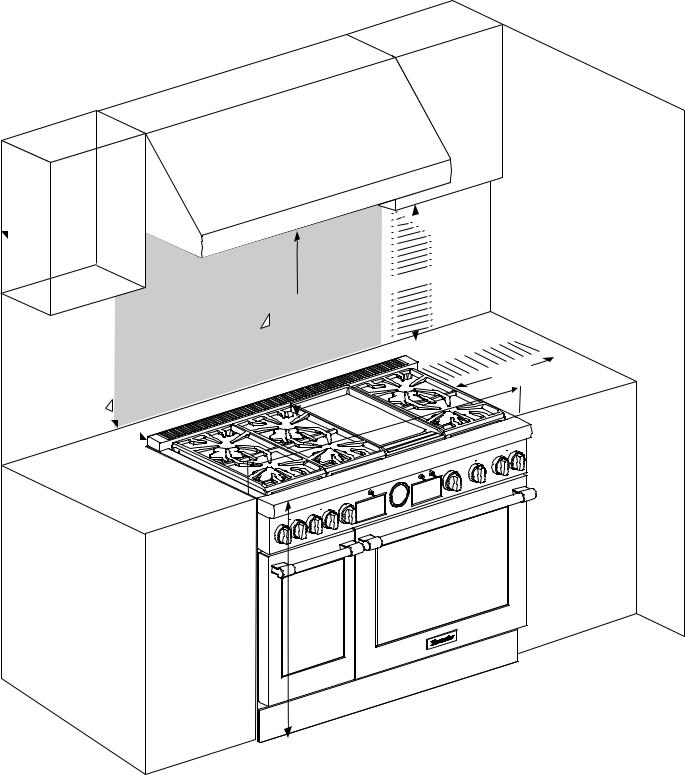
Cabinet clearance requirements with the included island trim
13" (330) 
6" |
(152) |
|
|
|
|
|
7) |
|
|
|
||
|
" |
(45 |
||
8 |
|
|
|
|
1 |
|
|
|
|
30" |
(762) |
– |
|
|
|||
|
|
||
36" |
(914) |
|
|
|
|
|
|
|
) |
7 |
|
"(12 |
|
5 |
|
36" |
or |
48" |
) |
||
219 |
|||||
|
|||||
|
|
||||
(914 |
or 1 |
|
|
||
|
|
|
|
||
35 ⅞" (911) –
36 ¾" (933)
inches (mm)
as defined in the “National Fuel Gas Code” (ANSI Z223.1, Current Edition). Clearances from non-combustible materials are not part of the ANSI Z21.1 scope and are not certified by CSA. Clearances of less than 6'' (152 mm) should be approved by the local codes and/or by the local authority having jurisdiction.
Page. 8
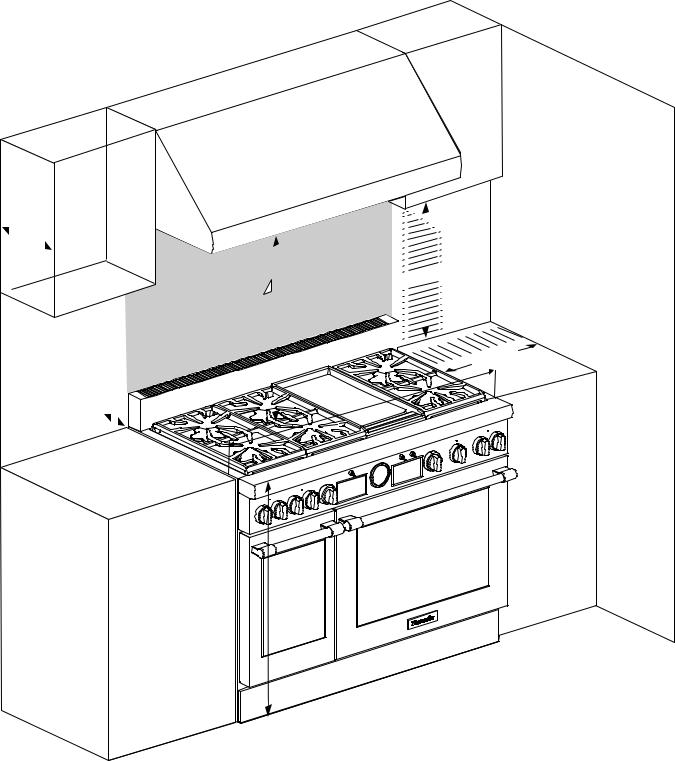
Cabinet clearance requirements with a low backguard (purchased separately)
13" (330)
|
|
(762) |
– |
30" |
|
||
|
|
||
36" |
(914) |
|
|
|
|
|
|
18"
(457)
 0"
0"
|
) |
7 |
|
"(12 |
|
5 |
|
36" |
or |
48" |
) |
||
|
|||||
|
1219 |
||||
|
|
||||
(914 |
or |
|
|
|
|
|
|
|
|
|
|
35 ⅞" (911) –
36 ¾" (933)
inches (mm)
as defined in the “National Fuel Gas Code” (ANSI Z223.1, Current Edition). Clearances from non-combustible materials are not part of the ANSI Z21.1 scope and are not certified by CSA. Clearances of less than 6'' (152 mm) should be approved by the local codes and/or by the local authority having jurisdiction.
Page. 9
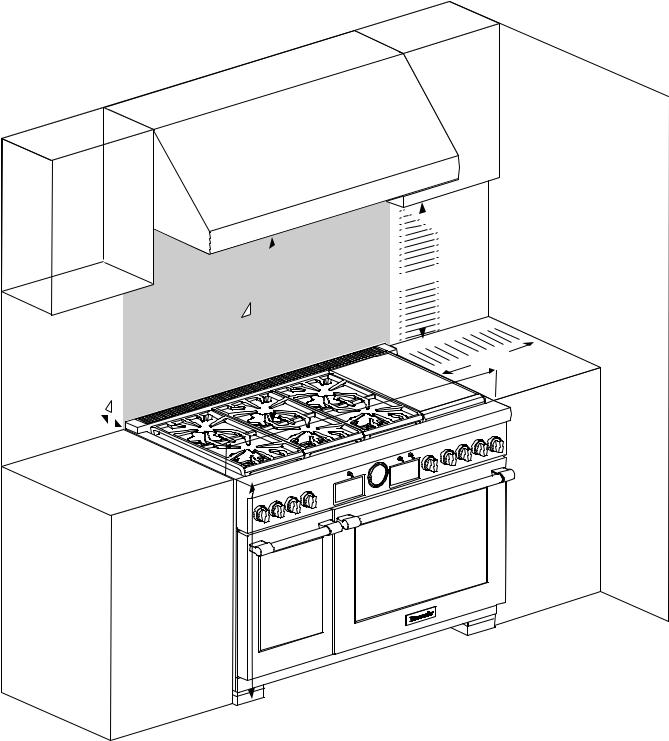
Cabinet clearance requirements for the 60'' range with the included island trim
 13" (330)
13" (330) 
|
" |
(457) |
8 |
|
|
1 |
|
|
30" |
(762) |
– |
|
|
|||
|
|
||
36" |
(914) |
|
|
|
|
|
|
5"
0" |
60" |
(15 |
24) |
|
|
||
|
|
|
35 ⅞" (911) –
36 ¾" (933)
|
) |
7 |
|
(12 |
|
inches (mm)
as defined in the “National Fuel Gas Code” (ANSI Z223.1, Current Edition). Clearances from non-combustible materials are not part of the ANSI Z21.1 scope and are not certified by CSA. Clearances of less than 6'' (152 mm) must be approved by the local codes and/or by the local authority having jurisdiction.
Page. 10
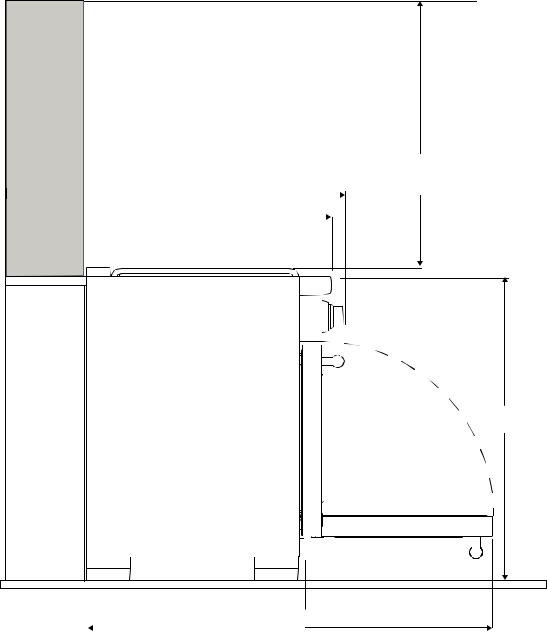
Side clearances
 6" (152)
6" (152) 
30" (762) – 36" (914)
 28" (711)
28" (711)
 27¼" (692)
27¼" (692)
 25⅛" (638)
25⅛" (638)
35⅞" (911) – 36¾" (933)
 26⅞" (683)
26⅞" (683)
inches (mm)
 48¾" (1238)
48¾" (1238)
•The model shown is with the included island trim. A low backguard option is available (purchased separately).
•For an island trim install, counter surface should have a cantilever edge meeting the back section of the island trim.
•If an inner wall is used under the cantilever counter top there should be a 1/8'' (3 mm) gap from the rear of the range.
•There is a 48-3/4'' (1,238 mm) total clearance.
•Shaded area behind range indicates minimum clearance to combustible surfaces. Combustible materials cannot be located within this area with the island trim.
•There is a 25-1/8'' (638 mm) maximum recess depth.
Page. 11
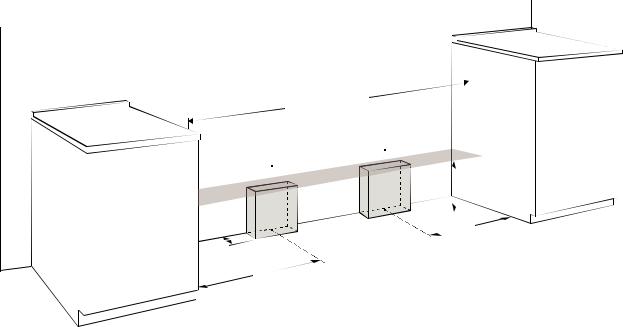
Gas and electric locations
•The gas and electrical supplies must be within the zones as indicated in the image below.
Gas and electrical requirements
•IMPORTANT: If not already present, install gas shutoff valve in an easily accessible location. Make sure all users know where and how to shut off the gas supply to the range.
•Any opening in the wall behind the appliance and any opening in the floor under the appliance must be sealed.
•The range must be connected only to the type of gas for which it is certified. If the range is to be connected to propane gas, ensure that the propane gas supply tank is equipped with its own high pressure regulator in addition to the pressure regulator supplied with the range.
•A manual gas shut-off valve must be installed external to the appliance, in a location accessible from the front, for the purpose of shutting off the gas supply. The supply line must not interfere with the back of the unit.
•The range is supplied with its own pressure regulator that has been permanently mounted within the range body.
•For nearly-flush installation to the back wall, the gas supply line and electrical cord should not go above 10'' (254 mm) above the floor.
•When the power supply cord or conduit is connected to the mating receptacle or terminal block cover, the combined plug/receptacle or terminal block cover/ conduit connector should protrude no more than 2'' (51 mm) from the rear wall.
36", 48", |
60" |
(914, 1219, |
1524) |
|
|
Electric |
|
|
|
Gas |
Zone |
|
|
|
|
|
|
|
|
Zone |
|
|
|
|
|
|
|
|
|
|
C |
10" |
|
|
|
L |
(254) |
|
|
|
|
||
|
C |
|
|
|
2" |
L |
|
|
|
|
|
|
|
|
(51) |
|
|
|
B |
A |
inches (mm) |
|
Model |
|
A |
|
B |
|
|
|
|
|
36'' (913 mm) |
4 |
½'' (123 mm) |
4 |
½'' (123 mm) |
|
|
|
|
|
48'' (1,219 mm) |
6 |
– 7/16'' (163 mm) |
6 |
– 7/16'' (163 mm) |
|
|
|
|
|
60'' (1,524 mm) |
4 |
½'' (123 mm) |
4 |
½'' (123 mm) |
|
|
|
|
|
Page. 12
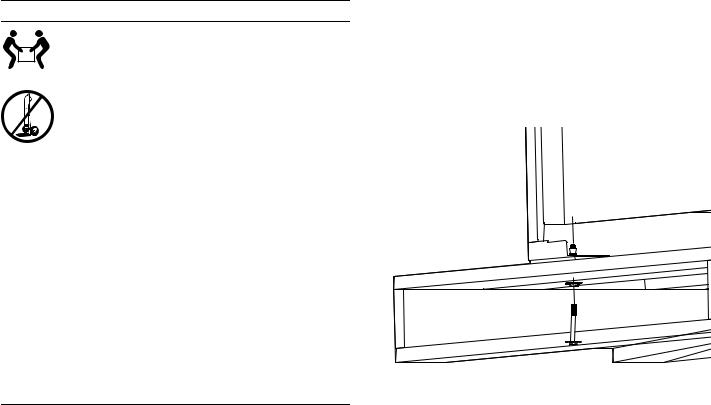
Unpacking and moving the range
9 CAUTION
DO NOT lift the range by the oven door’s handle, as this may damage the door hinges and cause the door to fit incorrectly.
DO NOT lift the appliance by the range’s control panel.
The unit is heavy and should be handled accordingly. Proper safety equipment such as gloves and adequate manpower of at least two people must be used in moving the range to avoid injury and to avoid damage to the unit or the floor.
Rings, watches, and any other loose items that may damage the unit or otherwise might become entangled with the unit should be removed.
Hidden surfaces may have sharp edges. Use caution when reaching behind or under appliance.
DO NOT use a hand truck or appliance dolly on the back or front of the unit. Handle from the side only.
Unpacking the range
NOTES:
•DO NOT remove control panel foam until unit is completely installed.
•DO NOT lift on the control panel at any point during the installation.
To unpack the appliance
1.Remove the outer carton and packing materials from the shipping pallet.
2.Leave the protective film over brushed-metal surfaces, to protect finish from scratches, until the range is installed in its final position.
3.Remove the grates, burner caps and oven racks to facilitate handling.
4.If desired, the oven doors may be removed (see “Door removal and adjustment”).
Moving the range
Due to the weight, a furniture dolly with soft wheels or an air lift should be used to move this unit. The weight must be supported uniformly across the bottom.
To remove the pallet bolts
1.To remove the pallet bolts in the front and in the back, use a 7/16'' wrench or ratchet and socket to remove the pallet bolt from the bottom of the pallet.
2.Lift range and remove it from the pallet. Use additional help as required to remove from pallet.
3.Transport the range by furniture dolly close to its final location. Unit should not be dollied from the front. DO NOT slide the range across an unprotected floor.
4.The range can then be tipped back and supported on the rear legs while the dolly is carefully removed. THE FLOOR UNDER THE LEGS SHOULD BE PROTECTED BEFORE PUSHING THE UNIT INTO POSITION.
Page. 13
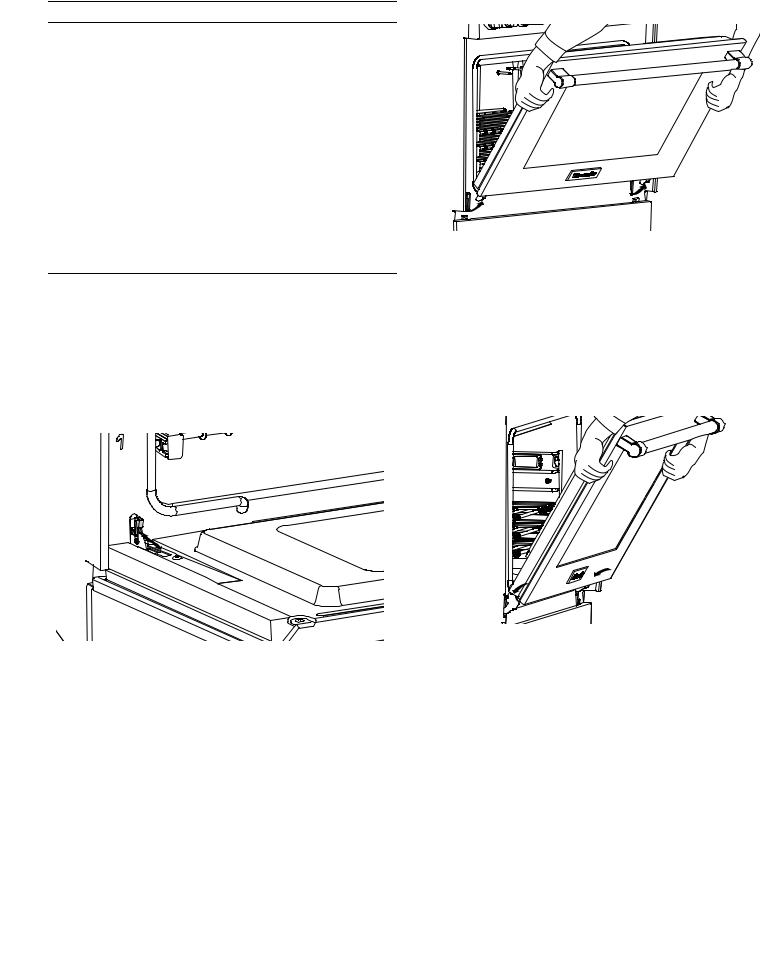
Door removal and adjustment
9CAUTION
•USE CAUTION WHEN REMOVING THE DOOR. THE DOOR IS VERY HEAVY.
•Make sure oven is cool and power to the oven has been turned off before removing the door. Failure to do so could result in electrical shock or burns.
•The oven door is heavy and fragile. Use both hands to remove or replace the door.
•Failure to grasp the oven door firmly and properly could result in personal injury and product damage.
•With the door off, never release the levers and try to close the hinges. Without the weight of the door, the powerful springs will snap the hinges closed with great force.
To remove the oven door
1.Be sure to read the above CAUTION before attempting to remove the door.
2.Open the door fully.
3.Flip the hinge clips for both sides of the door. A screwdriver may be required to carefully pry the clip.
4.Close the door gently until it stops against the hinge clips. The open hinge clips will hold the door open at a slight angle, about 30°, from the closed position.
5.Grasp the door firmly on the ends of the door. Lift the door up and out. There will be some spring resistance to overcome.
6. Place the door in a safe and stable location.
To reinstall the oven door
1.Hold the door firmly in both hands.
2.Hold the door at a 30° angle from the closed position. Insert hinges centered evenly into the hinge slots. The hinges will securely hook into the slots when properly installed. DO NOT force, bend or twist the door.
3. Open door fully to expose hinges, levers, and slots.
Page. 14
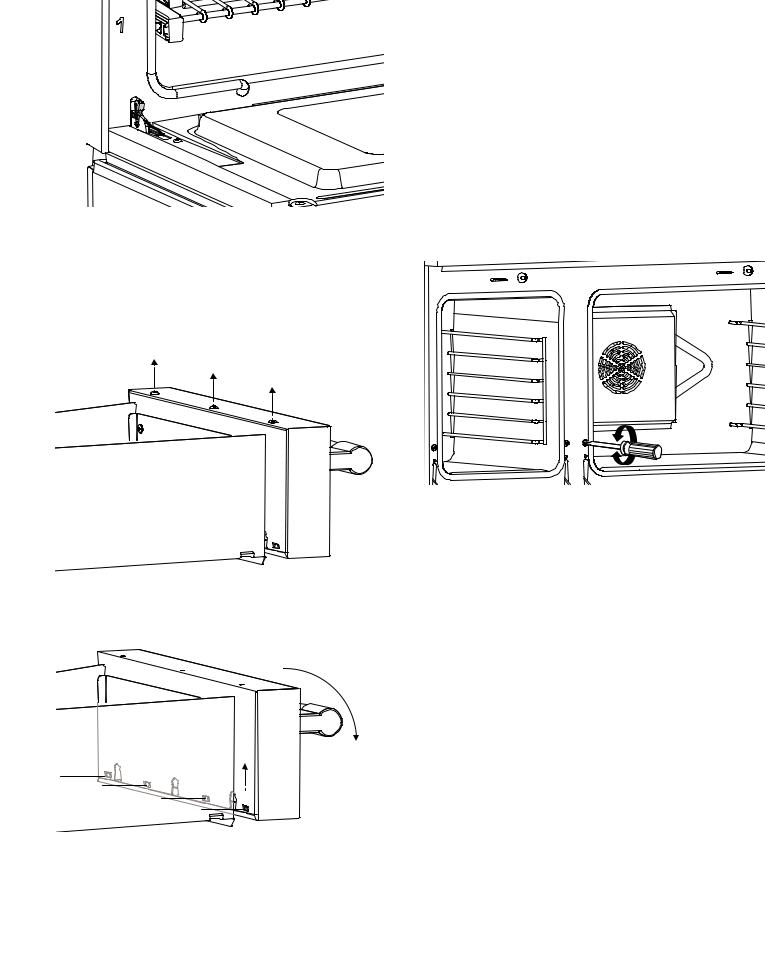
4.Flip the hinge until seated on the bracket. A screwdriver may be required to carefully push the clip.
5.Close and open the door slowly to ensure it is correctly and securely in place.
To remove the warming drawer
1.On the top of the warming drawer door, remove the three (3) T-20 torx screws.
2.Rotate the warming drawer door out and then pull down to disengage from the retainer tabs.
1
2
To check door fit and adjustment
1.Open and close the door slowly to test the movement and the fit of the door to the oven cavity. DO NOT force the door to open or close. If the door is properly installed, it should move smoothly and rest straight on the front of the range when closed.
2.The range must be level for proper alignment of the oven doors, see “Placing and leveling the range”.
3.Verify that the hinges are properly seated into the hinge slots, and that the hinge clips are fully engaged into the slots.
If door or handle appears slightly tilted
4.Rotate the large torx head screw located directly above the hinge receiver with a T-30 torx driver. Rotate each screw respective to its side and direction the door needs to be adjusted.
NOTE: The steam oven door is not adjustable.
Page. 15

Installing the anti-tip bracket (required)
•Contact a qualified installer or contractor to determine the proper method for drilling holes through the wall or floor material (such as ceramic tile, hardwood, etc.)
For all ranges, an anti-tip device must be installed as per these instructions.
9 WARNING
RANGE TIPPING HAZARD:
• All ranges can tip and injury can result. To prevent accidental tipping of the range, attach it to the floor by installing the anti-tip bracket supplied.
• A risk of tip-over may exist if the appliance is not installed in accordance with these instructions. For all ranges an anti-tip device MUST be installed.
•A child or adult can tip the range and be killed.
•DO NOT operate the range without the anti-tip device in place and engaged. Failure to do so can result in death or serious burns to children or adults.
•If the range is pulled away from the wall for cleaning, service or for any other reason, ensure that the anti-tip device is properly re-engaged when the range is pushed back against the wall. In the event of abnormal usage (such as a person standing, sitting, or leaning on an open door), failure to take this precaution can result in tipping of the range. Personal injury might result from spilled hot liquids or from the range itself.
•The bracket may be attached to a solid wood surface having a minimum wall thickness of ¾'' (19 mm).
•The thickness of the wall or floor may require use of longer screws, available at your local hardware store.
•In all cases, at least two (2) of the bracket mounting screws must be fastened to solid wood surface.
•Use appropriate anchors when fastening the mounting bracket to any material other than hard-wood or metal.
•If the range is moved to a new location, the anti-tip device must be removed and reinstalled.
Anti-tip bracket installation
Installing the anti-tip bracket for 36'' and 48'' models
1.Locate the anti-tip bracket in the literature packet, inside the box that was on top of the appliance.
2.Place bracket on the floor in a position shown below. The bracket may be placed on either the left or the right side.
3.For walls, wall studs, or floors composed of solid wood or metal, drill 1/8'' (3 mm) pilot holes.
4.Secure to floor and/or wall stud using the (4) 1 ½'' (38 mm) Phillips head screws provided.
9 WARNING
ELECTRICAL SHOCK HAZARD:
•Use extreme caution when drilling holes into the wall or floor as there may be concealed electrical wires.
•Identify the electrical circuits that could be affected by the installation of the anti-tip bracket, then turn off power to these circuits.
•Failure to follow these instructions may result in electrical shock or other personal injury.
IMPORTANT:
•Hardware provided is for mounting through standard thickness wood studs. Installers are responsible to provide hardware for other types of mounting situations.
|
C |
|
L |
C |
C |
L |
L |
x |
x |
Model |
Value for 'X' |
36'' |
3-7/8'' (98 mm) |
48'' steam models only |
1-5/8'' (41 mm) |
48'' all other models |
1-3/4'' (44 mm) |
Later, when the unit is installed, the adjustable leg will slide under the bracket.
Page. 16
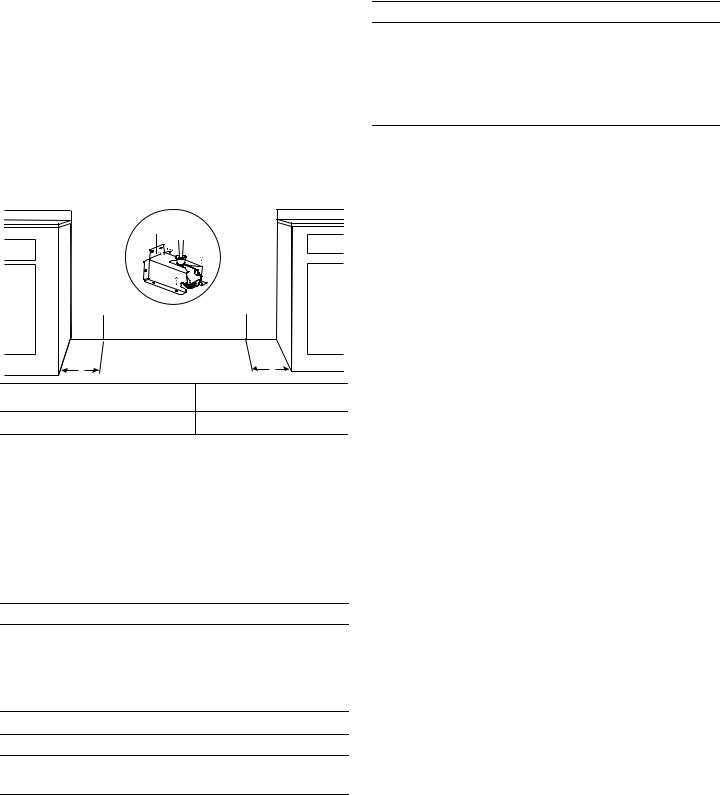
Installing the anti-tip bracket for 60'' models |
9 CAUTION |
||
|
|
||
1. Locate the anti-tip bracket in the literature packet, |
When connecting unit to propane gas, make certain |
||
inside the box that was on top of the appliance. |
the propane gas tank is equipped with its own high |
||
2. Place bracket on the floor in a position shown below. |
pressure regulator in addition to the pressure |
||
regulator supplied with the appliance. The pressure of |
|||
The bracket may be placed on either the left or the |
|||
the gas supplied to the appliance regulator must not |
|||
right side. |
|
||
|
exceed 14" water column (34.9 mb). |
||
3. For walls, wall studs, or floors composed of solid |
|||
|
|||
wood or metal, drill 1/8'' (3 mm) pilot holes. |
Verify the type of gas being used at the installation site. |
||
4. Secure to floor and/or wall stud using the (4) 1 ½'' |
|||
Make certain the range matches the type of gas available |
|||
(38 mm) Phillips head screws provided. |
|||
at this location. |
|||
|
|
||
|
C |
The gas supply connections shall be made by a competent |
|
|
technician and in accordance with local codes or |
||
|
L |
||
|
|
||
|
|
ordinances. In the absence of local codes, the installation |
|
|
|
must conform to the National Fuel Gas Code ANSI |
|
|
|
Z223.1/NFPA54current issue. |
|
C |
C |
|
|
L |
L |
High altitude |
|
|
|
||
|
|
This appliance has been tested for operation up to an |
|
x |
x |
altitude of 10,100 ft (3,078 m) elevation above sea level. |
|
Model |
Value for 'X' |
If desired, for altitudes above 2,000 feet (610 m) elevation |
|
60'' |
2'' (51 mm) |
above sea level, adjustments can be made with a High |
|
Altitude Kit. If flame performance is satisfactory, |
|||
|
|
||
Later, when the unit is installed, the caster will slide under |
adjustment will not be required. It is required that a |
||
Certified Professional make the high altitude adjustments |
|||
the bracket. If the range is moved to a new location, the |
|||
during installation. |
|||
anti-tip device must be removed and reinstalled. |
|||
|
|||
Gas requirements and connection
9 CAUTION
The appliance must be isolated from the gas supply piping system by closing its individual manual shut-off valve during any pressure testing of the gas supply piping system at test pressures equal to or less than 1/ 2 psig (3.5kPa.).
9 WARNING
DO NOT use a flame of any kind to check for gas leaks.
Gas requirements
Natural gas requirements:
•Inlet Connection: 1/2'' NPT internal (Minimum 3/4'' dia. flex line)
•Supply Pressure: 7'' min. to 14'' max. water column (17.4 to 34.9 mb)
•Manifold Pressure: 5'' water column (12.5 mb)
Propane gas requirements:
•Inlet Connection: 1/2'' NPT internal (Minimum 3/4'' dia. flex line)
•Supply Pressure: 11'' min. to 14'' max. water column (27.4 mb to 34.9 mb)
•Manifold Pressure: 10'' water column (24.9 mb)
Page. 17

Gas connection
To connect the gas
1.Make sure the gas supply is turned off at the manual shut-off valve before connecting the appliance.
2.Use a ¾'' (19 mm) flex line to connect between the gas supply and the appliance gas inlet. The gas supply line connection is located at the lower right portion. The appliance gas inlet connection is ½'' (12.7 mm) NPT.
•Use caution to avoid crimping the ¾'' (19 mm) flex line when making bends. Suggested length of flex line is 48" (1219 mm); however, please check local codes for your area's requirements before installation.
Electrical requirements and connection for GAS models
9 WARNING
Before installing, turn power OFF at the service panel. Lock service panel to prevent power from being turned ON accidentally. Always disconnect appliance from the electric supply either by disconnecting power cord or shutting off the breaker at the service panel before servicing the appliance.
9 WARNING
This product must be properly grounded.
¾" (19) external threads |
|
½" (12.7) internal threads |
{ |
|
|
¾" (19) 




 Flex line
Flex line
inches (mm)
3.Use pipe sealing compound or Teflon® tape on the pipe threads. DO NOT apply sealing compound or tape to flare fittings. Take care not to apply excessive pressure when tightening the fittings.
4.Leak testing of the appliance shall be in accordance with the following instructions:
•Turn on gas and check supply line connections for leaks using a soap and water solution.
5.Bubbles forming indicate a gas leak. Repair all leaks immediately.
9 WARNING
Electrical grounding instructions
This appliance is equipped with a three-prong grounding plug for your protection against shock hazard and should be plugged directly into a properly grounded receptacle. DO NOT cut or remove the grounding prong from this plug.
9 CAUTION
Improper grounding or reverse polarization will cause malfunction (such as continuous sparking of the burner igniters). This can damage the appliance and can create a condition of shock hazard. If the dedicated circuit is not correctly grounded and polarized, it is the responsibility and obligation of the installer and user to have the existing receptacle changed to a properly dedicated grounded and polarized receptacle. This must be accomplished in accordance with all applicable local codes and ordinances by a qualified electrician. In the absence of local codes and ordinances, the receptacle replacement shall be in accordance with the National Electric Code.
INSTALLER — show the owner the location of the circuit breaker. Mark it for easy reference.
Page. 18
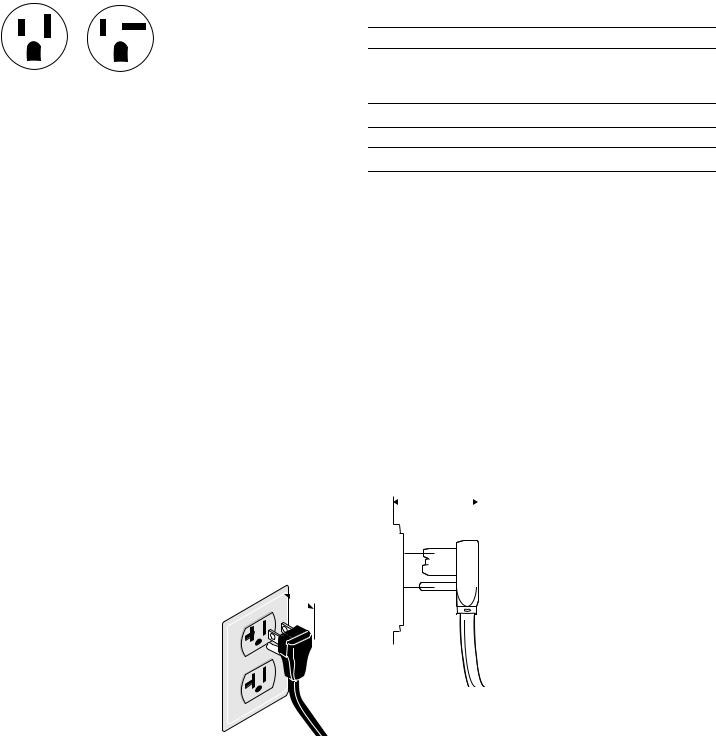
Gas unit electrical connection
Electrical supply circuit requirements |
|
||
NEMA 5-15 |
NEMA 5-20 |
The cord supplied with the |
|
|
|
gas ranges having an electric |
|
N |
N |
griddle or grill requires a |
|
|
NEMA 5-20 receptacle. All |
||
|
|
||
G |
G |
other gas units require a |
|
|
|||
|
|
NEMA 5-15 receptacle. |
|
|
|
|
|
Model |
Voltage |
Dedicated circuit |
Phase |
|
|
|
|
Pxx305Wx |
120 VAC |
15 Amps |
Single |
|
|
|
|
Pxx366Wx |
120 VAC |
15 Amps |
Single |
|
|
|
|
Pxx364WDx |
120 VAC |
20 Amps |
Single |
|
|
|
|
Pxx364WLx |
120 VAC |
20 Amps |
Single |
|
|
|
|
Pxx486WDx |
120 VAC |
20 Amps |
Single |
|
|
|
|
Pxx486WLx |
120 VAC |
20 Amps |
Single |
|
|
|
|
•Before you plug in an electrical cord, be sure all controls are in the OFF position.
•A neutral supply wire must be provided from the power source (breaker) because critical range components, including the surface burner spark reignition modules, require it to operate safely and properly.
•All 120 volt models must be plugged into a mating 3- prong, grounding-type receptacle. The receptacle must be connected to a properly dedicated grounded and polarized electrical power supply rated at 120VAC, Single Phase, 60Hz.
•Observe all governing codes and ordinances when grounding. In the absence of these codes or ordinances observe National Electrical Code ANSI/ NFPA No. 70 current issue, or the relevant Canadian Electric Code, CSA C22.1-02.
•Power cord and receptacle
should protrude no more than |
2" |
2'' (51 mm) from the rear wall. |
(51) |
|
|
NOTE: Plug styles may vary. |
|
Electrical requirements and connection for DUAL FUEL models
9 WARNING
An improper 240/208 VAC power supply will cause malfunction, damage to this appliance, and possibly create a condition of shock hazard.
9 WARNING
This product must be properly grounded.
•Before installing, turn power OFF at the service panel. Lock service panel to prevent power from being turned ON accidentally.
•Prior to servicing appliance, always disconnect appliance electrical supply cord, if so equipped, from wall receptacle. If appliance is hard-wired to power supply, disconnect power to unit by turning off the proper circuit breaker. Lock service panel to prevent power from being turned ON accidentally.
•A neutral supply wire must be provided from the power source (breaker) because critical range components, including the surface burner spark reignition module, require it to operate safely and properly.
•Mount the receptacle securely to a wall stud, then seal around the receptacle's housing.
|
|
2" (51) max. |
|
|
|
When using a receptacle it may |
||||
|
|
|
|
|
|
|
|
|
|
be necessary to recess the |
|
|
|
|
|
|
|
|
|
|
|
|
|
|
|
|
|
|
|
|
|
receptacle's housing into the rear |
|
|
|
|
|
|
|
|
|
|
wall. Refer to Local Electrical |
|
|
|
|
|
|
|
|
|
|
Code to determine the minimum |
|
|
|
|
|
|
|
|
|
|
volume for all electrical / junction |
|
|
|
|
|
|
|
|
|
||
|
|
|
|
|
|
|
|
|
||
|
|
|
|
|
|
|
|
|
|
boxes. Follow all local electrical |
|
|
|
|
|
|
|
|
|
||
|
|
|
|
|
|
|
|
|
|
codes and ordinances, and/or the |
|
|
|
|
|
|
|
|
|
|
National Electric Code, as |
|
|
|
|
|
|
|
|
|
||
|
|
|
|
|
|
|
|
|
|
applicable. |
|
|
|
|
|
|
|
|
|
|
|
|
|
|
|
|
|
|
|
|
|
|
Volt |
Circuit |
Frequency |
Phase |
|
|
|
|
240/208 VAC |
50 Amps |
60 Hz. |
Single |
|
|
|
|
Page. 19

•If the correct power supply circuit is not provided, it is the responsibility and obligation of the installer and user to have proper power supply connected. This must be accomplished in accordance with all applicable local codes and ordinances by a qualified electrician. It is the responsibility of the installer to ensure compliance of local codes. In the absence of local codes and ordinances, the power supply connection shall be in accordance with the National Electric Code.
•Observe all governing codes and ordinances when grounding. In the absence of these codes or ordinances observe National Electrical Code ANSI/ NFPA No. 70 current issue. See the following information in this section for grounding method.
•Electrical wiring diagrams and schematics have been placed in the kick panel area of the range for access by a qualified service technician.
•The ranges are to be connected to a 240/208 VAC power supply.
•Dual Fuel models must be connected to the power supply utilizing one of the following methods. For all methods of connection, the length of the cord or conduit/wiring must allow the unit to be slid completely out of the cabinet without having to unplug or disconnect the unit from the power supply.
•Recommended minimum free length of cord or conduit is 4ft (1.2 m). Electrical installations and grounding must be in accordance with all local codes and ordinances, and/or the National Electric Code, as applicable.
4-wire connection
This appliance must be connected to the power supply with a listed (UL, CSA, ...) 3-POLE, 4-CONDUCTOR cord kit rated 125/250 VOLTS, 50 AMPERES DEDICATED CIRCUIT, and marked for use with ranges. It is the responsibility of the installer to provide the proper wiring components (cord, wires, etc.) and complete the electrical connection as dictated by local codes and ordinances, and/or the National Electrical Code.
The cord kit is required to be attached to the range terminal block with a strain relief (not provided) which will fit a 1'' (25.4 mm) diameter hole. If not already equipped, the cord must also have 1/4'' (6 mm) faston closed-loop lugs attached to the free ends of the individual conductors, preferably soldered in place.
To wire a 4-wire connection
1.Locate the terminal block on the rear of the unit and remove cover.
2.Remove upper nuts only from the terminal block studs. DO NOT remove lower nuts which secure range internal wiring leads.
3.If applicable, remove the 4-wire power cord from the appliance.
4.Mount strain relief (not provided with range) into the 1'' (25.4 mm) diameter hole in the back panel located below the terminal block. Route wires up through strain relief.
5.Remove green ground screw and serrated washer located beneath the terminal block.
6.Secure the neutral, grounded wire of the supply circuit, to the center stud of the terminal block with nut.
7.Secure the L1 (red) and L2 (black) power leads to the outside terminal studs (brass colored) with nuts.
8.Secure the bare copper ground lead to the range chassis using the ground screw and serrated washer. Be sure that neutral and ground terminals do not touch.
|
c |
|
a |
|
B |
a – Red/L1 |
b – Green/ground |
c – White/neutral |
d – Black/L2 |
9.Tighten all connections securely and
10.Reinstall the terminal block cover.
Page. 20
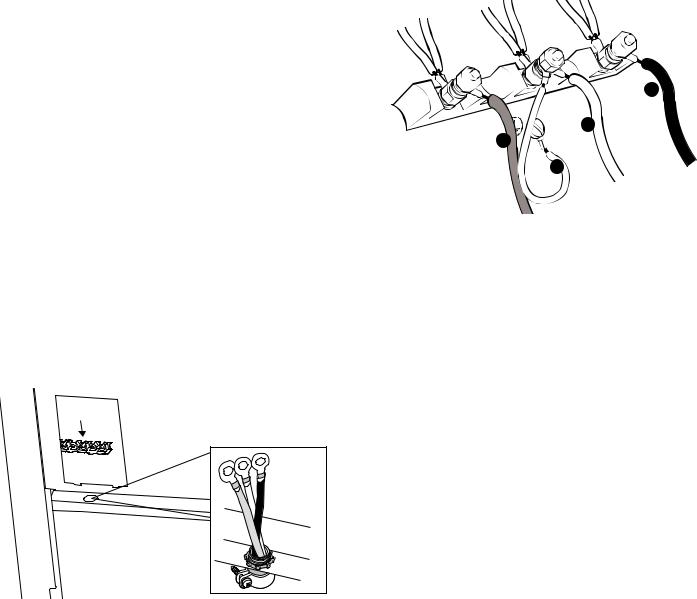
3-wire lead connection
Where local codes and ordinances permit grounding through neutral, and conversion of supply to 4-wire is impractical, the unit may be connected to the power supply with a Listed (UL, CSA, ...) 3-POLE, 3- CONDUCTOR cord kit rated 125/250 VOLTS, 50 AMPERES DEDICATED CIRCUIT, and marked for use with ranges. It is the responsibility of the installer to provide the proper wiring components (cord, wires, etc.) and complete the electrical connection as dictated by local codes and ordinances, and/or the National Electrical Code.
The cord kit must be attached to the range back panel with a strain relief which will fit a 1" (25.4 mm) diameter hole. If not already equipped, the cord must also have 1/4'' (6 mm) faston closed-loop lugs attached to the free ends of the individual conductors, preferably soldered in place.
To wire a 3-wire connection
1.Locate the small bag with white jumper wire located in the literature packet.
2.Locate the terminal block on the rear of the unit and remove cover.
3.Remove upper nuts only from the terminal block studs. DO NOT remove nuts which secure range internal wiring leads.
4.If applicable, remove the 4-wire power cord from the appliance.
5.Mount strain relief (not provided with range) into the 1'' (25.4 mm) diameter hole in the back panel located below the terminal block. Route wires up through strain relief.
6.Secure the neutral, grounded wire of the supply circuit, to the center stud (silver colored) of the terminal block.
7.Secure the L1 (red) and L2 (black) power leads to the outside corresponding terminal block studs (brass colored).
8.Remove the green ground screw and serrated washer located beneath the terminal block. Screw one end of the included white jumper wire to the chassis beneath the terminal block with the green ground screw.
Secure the other end of the wire to the center stud of the terminal block with nut.
|
c |
|
a |
|
B |
a – Red/L1 |
b – Ground link wire provided |
|
in small bag. |
c – White/neutral |
d – Black/L2 |
9.Tighten nuts securely.
10.Reinstall the Terminal Block Cover.
Page. 21
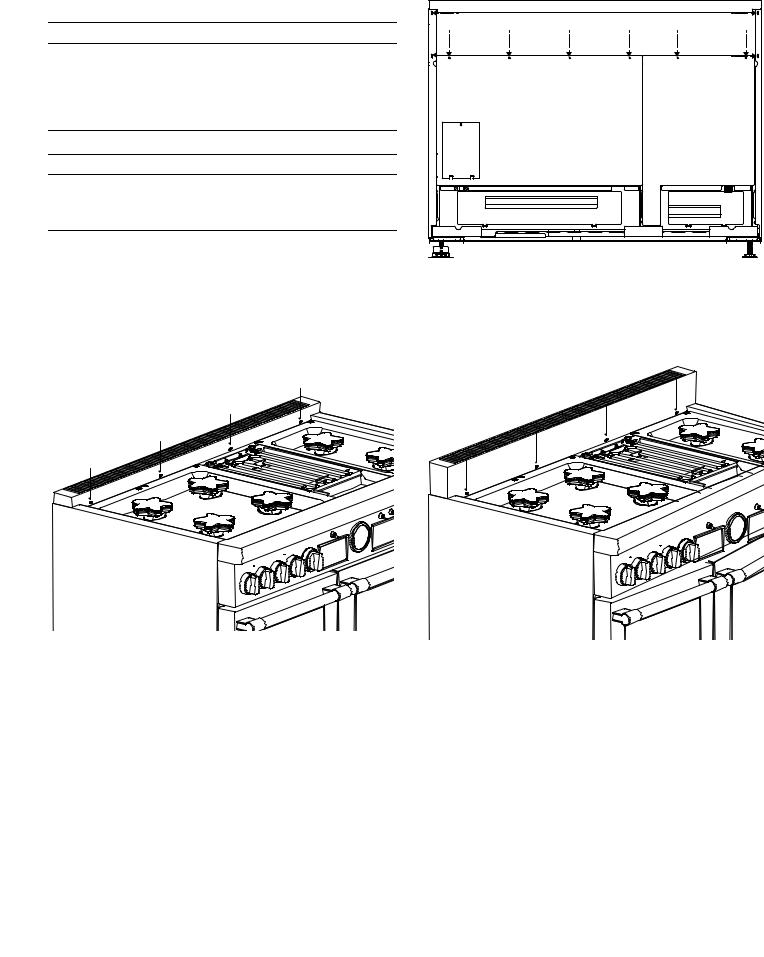
Low backguard installation (optional)
9 WARNING
Fingers or hands could get pinched when installing the backguard. Severe injury could result. Use extreme caution and wear thick protective gloves to avoid potential laceration to finger or hand while sliding the backguard down onto the range.
9 WARNING
To reduce the risk of fire or injury to persons, ensure all packaging has been removed from accessory devices before use.
Installation methods will vary upon need. Before you begin read these instructions carefully. Observe all local codes and ordinances.
To install the low backguard
1.Remove the T-20 torx stainless screws in the front face of the included island trim.
2.Remove the drill point screws securing the piece to the back panel. Lift up to fully remove.
3.Align the back panel of the new accessory with the flanges on the range side panels right and left rear corners. Make sure the backguard front face is outside the flange on the front side of the range.
4. Reinstall screws removed in Steps 1 and 2.
Page. 22
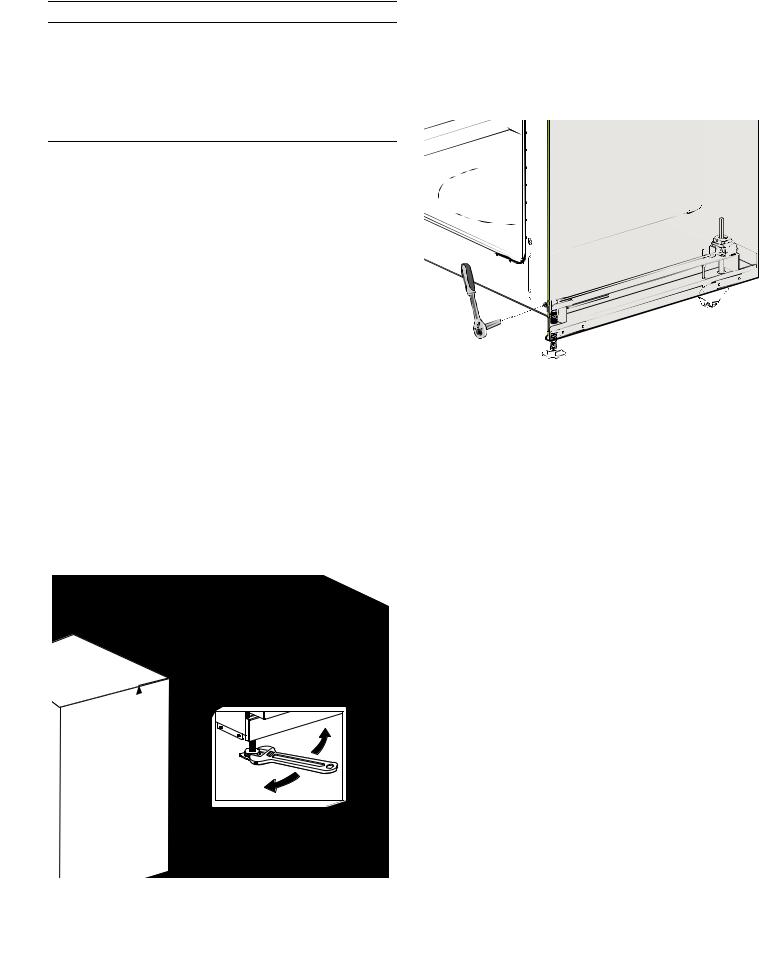
Placing and leveling the range
9 CAUTION
The top edges of the range’s side panels must be on the same or higher level as the adjacent countertop. DO NOT operate range if sides are lower than the adjacent cabinet. If the range is operated while at a lower height relative to the adjacent cabinet, the cabinet could be exposed to excessive temperatures, causing damage to the cabinet and countertop.
Leveling leg adjustment
For proper performance, the range must be level. Priority should be placed on ensuring that the oven cavities are also level for optimum cooking performance.
To level 36'' and 48'' models
1.Measure the countertop heights first with a tape measure and add an additional 1/16'' - 1/8'' (2-3 mm).
2.Rotate the legs using a 12'' (305 mm) adjustable wrench on the flat sides of each foot.
•Leveling legs should be adjusted so that the range sides are at the same or higher level as the adjacent cabinet. Adjust the legs accordingly prior to pushing the range back to its final location.
•It may be necessary to reposition the gas supply line and the electrical cord as the range is pushed back to its final position. This may be accomplished by carefully pulling on a rope or twine looped around the gas or electrical supply line as the range is pushed back into its final installed position.
inches (mm)
1/16''-1/8'' 














 (2-3)
(2-3) 



3.As the range is moved into its final, installed position, verify that the anti-tip bracket is in a position to engage the appliance.
To level 60'' models
1.Height adjustments of the two rear caster legs are made by turning the 5/16'' socket located behind the front frame.
•Rotation direction will vary depending on which side of the appliance is being adjusted.
•The oven doors must be removed in order to access the leveling socket for the rear wheels (see “Door removal and adjustment”. On models with a warming drawer, the socket for the left caster may be accessed by pulling the warming drawer open.
2.With the range in the installed position, the final height adjustments are made to the two front legs to ensure proper alignment to the counter top.
3.Lower the center leveling foot of the unit to help support the appliance weight.
4.Reinstall the oven doors (refer to “Door removal and adjustment”).
Page. 23
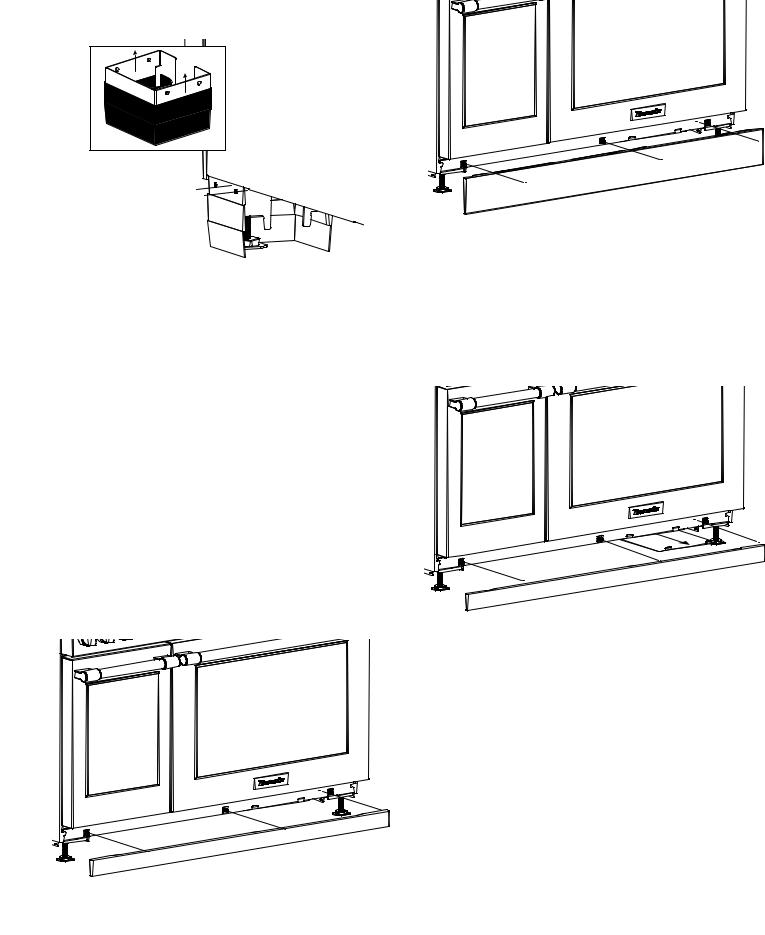
Installing the leg covers
To install the leg covers
1.Remove plastic coverings from the stainless steel covers.
2.Beneath the range, wrap the cover assembly around the leg.
3.Slide the outer cover up while the inner piece remains on the floor. The mating part has dimples for which the holes of the larger cover should seize. You should feel a definitive click, letting you know that the cover assembly has been mounted to the unit.
4.Repeat for all visible legs.
•If additional leg covers are required, they may be ordered from the service center by calling 1-800-735-4328 at no charge for up to one year after purchase date of the appliance.
Toe kick panel (optional)
To install the toe kick panel
1.Dismount the leg covers from the extruded dimples.
2.Remove the door trim from their mounting clips. (No tools required.)
3.Remove protective plastic covering from the toe kick panel.
4.Press the toe kick panel into the mounting clips.
Data rating label
Data rating label
The data rating label shows the model and serial number of your appliance. The slide-out plate can be accessed by first removing the kick panel, as shown below.
Electric wiring diagrams and schematics
The electric wiring diagrams and schematics are attached behind the toe kick, and should not be removed except by a service technician, then replaced after service.
Page. 24
